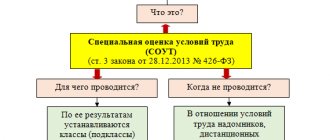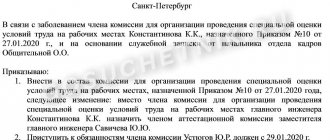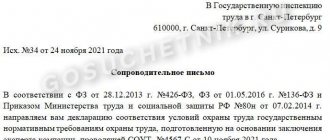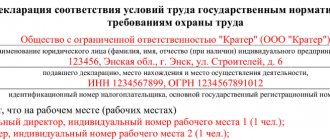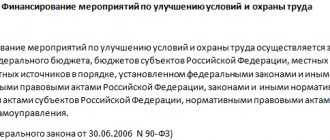What is a special assessment
A special assessment of working conditions is an event whose purpose is to determine the degree of influence of harmful factors on the employer’s employees. Depending on whether hazardous factors are detected or not and the extent of their impact on personnel, the employer makes a number of decisions, including:
- on providing additional guarantees to employees;
- on providing employees with personal protective equipment;
- on modernization of the production process to reduce harmfulness.
The mandatory nature of the special assessment and the algorithm for carrying out special assessments are enshrined in Federal Law No. 426-FZ dated December 28, 2013.
IMPORTANT!
Assessment of working conditions is mandatory for all employers, except for employers - individuals and religious organizations. Workplaces of homeworkers and remote workers are not subject to inspection.
Neglect of labor assessment threatens the employer with liability under Art. 5.27.1 Code of Administrative Offenses of the Russian Federation. The assessment procedure is fixed by law.
Read more: What are dangerous and harmful production factors
Brief step-by-step instructions for carrying out SOUT consists of the following elements, the implementation of each of which is mandatory:
Basics of carrying out SOUT
SOUT is a special assessment of work activity criteria, which has the goal of classifying the level of danger and harm in the workplace. Based on the results, the manager has the right to improve the working conditions of employees.
This process refers to a set of special measures, the purpose of which is to identify dangerous and harmful factors in the implementation of professional and labor activities. The audit may reveal that working conditions at the production site do not meet the standards set by the government. In this case, representatives of the audited organization will be required to implement recommendations to eliminate the negative impact.
Important! SOUT is a process that creates the environment for organizing work activities and the conditions necessary to protect the worker.
According to Art. 212 of the Labor Code of the Russian Federation, all companies and individual entrepreneurs are required to carry out special safety assessments in relation to the workplaces of hired workers participating in production and technological processes.
This rule applies to all workplaces except:
- vacant;
- home-based;
- remote;
- for places created by an individual without individual entrepreneur status (clause 3 of article 3 of Federal Law No. 426 of December 28, 2013).
The analysis of working conditions is based on the working environment and the impact of a number of factors on it. The employee comes into contact with these factors while performing work. They can be both beneficial and threaten his health or even life.
The SAL should be carried out with the participation of people properly prepared for this process. These should be people familiar with the provisions of labor protection rules relating to a specific type of work activity, related to ensuring proper working conditions, and issues of working conditions, for example, health and safety services, technologists.
When organizing SOUT, the employer must pay attention to:
- organization of workplaces, including placement of equipment, ensuring compliance with safety requirements in the workplace;
- condition of equipment components: is operation safety ensured, including protection against electric shock;
- load on the musculoskeletal system;
- burdening employees with physical factors: insufficient lighting;
- psychological stress on workers resulting from the organization of work.
Important! If it is determined that working conditions in certain workplaces may pose a threat to the health, safety or undue nuisance of employees, immediate action should be taken to improve those conditions by informing employees of the hazards and their nature.
The most important regulatory act that should be highlighted here is 426-FZ. The presented federal law defines the organizational basis for the rights, duties and responsibilities of assessment participants.
It should be noted that Federal Law No. 426 is far from the only regulatory act that defines the conditions and principles for the functioning of assessment work at a particular enterprise. There is also the Labor Code of the Russian Federation, as well as certain regulations at the local level.
It is necessary to highlight an important norm provided for in Article No. 2 of Federal Law No. 426. This indicates the principle of the priority of international law over national law. Therefore, this regulation must also comply with international standards.
Fines
Each of the above actions is mandatory; failure to perform any of them or violation of deadlines is punishable by fines. For officials, fines reach 10,000 rubles, for legal entities - 80,000 rubles. To avoid any grounds for liability, the company confirms each action within the framework of the assessment, for example, notifying the executing organization - with a notification of delivery of a letter, GIT - with the signature of its representative. The most efficient method seems to be courier delivery to the labor inspectorate, so you will be sure that your declaration is registered.
The entire “Summary Data” document is posted on your company’s website (if it has one) in scanned form with the signatures of the commission members.
Despite the multi-step nature of this procedure, it is not difficult to conduct a special labor assessment, since the performing companies provide documentary support and accompany the process at all stages of the work.
Common Mistakes
The main and most common mistake in the issue of SOUT is violation of deadlines or failure to carry out. At the same time, the rights of workers regarding working conditions and the determination of wages and compensation are violated.
Important! Further, among the errors, certification is carried out by an unaccredited company. Finding a licensed institution is the employer’s task. Otherwise, the report will be considered invalid.
The next typical mistake is the lack of awareness of employees about the results of the inspection. Federal Law No. 426 obliges the employer to familiarize all workers with the results no later than 30 calendar days. Not all workers agree with the results. This applies to cases where their rights are violated or certain points are not taken into account. Anyone who disagrees can file a claim in court to review the results of the certification. The results of the latest audit will allow new employees to study reliable information.
How often to declare workplace compliance
If, within 5 years after submitting the declaration, no accident has occurred at the workplaces listed in it or the employee has not acquired an occupational disease (this must be determined by a medical commission), the declaration is automatically extended until there are grounds for unscheduled control. If an accident occurs or other reasons appear (they are listed in Article 17 of Law No. 426-FZ), then the declaration to the State Tax Inspectorate after a special assessment will be canceled, and the organization will have to conduct an unscheduled special assessment.
What is a special assessment card for working conditions?
A special assessment card for working conditions is a document containing information about the employee’s place of work. To do this, you do not need to additionally use other documents.
It contains information:
- About the company where the certification is carried out.
- About an enterprise that provides services of a similar nature.
- Description of the work process.
- Parameters for measuring gas and dust levels in the air of the working area.
- Measurement parameters for noise, illumination and temperature and humidity conditions.
- What benefits are provided: shortened working hours, additional payments, additional leave, etc.
- How often are medical examinations carried out?
- What measures need to be taken to eliminate cases of injuries and occupational diseases.
A special assessment card for working conditions is a workplace passport, which contains all the comprehensive information about the employee’s working conditions in the organization. The employee must be familiar with the documents.
Filling algorithm
The special assessment card for the labor process is filled out sequentially. For this, the following information is taken into account:
- All information about the company conducting the certification. Name, address, location, license number and certificate of right to engage in this type of work.
- Data about the workplace and similar places.
- Indicate the SNILS number of employees.
- What negative environmental factors exist, how do they affect the body.
- What compensation are due to employees for harmful production conditions: a shortened day, how many days the vacation is increased, what amount of additional payment is due.
- List of measures according to which working conditions are improved.
- This information is provided from the company's certificate of incorporation, state schedule. The bulk of information is entered into the cards by experts, as well as by the management of the enterprise where the special assessment was carried out.
- Information from the administration data
Commission members
When preparing an organization to conduct a special assessment of workplaces, an administrative document is initially issued, which indicates the members of the commission in the organization. The commission includes:
| Commission members | A comment |
| Head of the facility | This is the chairman of the commission. He organizes control over the certification process and approves documents. In case of disagreement, organizes meetings at which all controversial issues are resolved. |
| HR Representative | Prepares a list of employees and a list of workplaces where certification is planned to be carried out. After approval of the list, work begins. |
| Health and Safety Specialist | Controls the certification process and helps commission members correctly assess the employee’s position, provides the commission with available documents on occupational safety upon their request, including administrative acts, instructions, personal cards for issuing personal protective equipment and training. |
| Chief power engineer and chief mechanic | Specialists are needed to show work sites and equipment on their farm. |
| Other specialists and managers of sites and facilities taking part in the certification. |
Members of the commission and the chairman must be familiar with the order to carry out work against signature. It is important that the date is placed next to the signature.
Recommendations on how to improve conditions
Based on the results of the work, experts provide information on improving working conditions. How it's done:
- An assessment is made of the risk of injury at the workplace. For example, where an employee may fall or an excess of a harmful factor is established. Then additional measures are prescribed: repair the floor covering or wear a respirator.
- Measures to reduce the level of danger are set out in a special plan, which is agreed upon with the management of the facility and must be completed in accordance with the deadlines.
- Activities that do not require costs are usually carried out in the near future. Those activities for which funds need to be spent are carried out at the time agreed with the employer.
- After signing the measures, the injury hazard class to which the workplace belongs is indicated.
An example of entering data into a special assessment card for working conditions
When filling out the card, use the instructions in the appendix. No. 4 to Order of the Ministry of Labor dated January 24, 2014 No. 33n.
Documents for SOUT, sample filling:
List of compensations
Compensation is provided for workers for work under special conditions:
- For exceeding harmful factors . After taking measurements of gas pollution, noise or dust levels, it turned out that the employee was working in excess. It is calculated how many times excesses are allowed. Based on what is received, the payout percentage is set. Typically from 4 to 12%. Accruals are made depending on the minimum tariff rate for the time actually worked.
- Depending on the type of work or profession, the time for additional days of vacation is established. For this purpose, there is a document regulating this circumstance.
- A shortened working day is also established for work in hazardous conditions based on standards.
- Preferential retirement experience is provided to the employee based on the norms.
All information is recorded in a card for a special assessment of working conditions and is taken as a basis when calculating compensation or providing additional rest time. That is, the concept of “additional payment for harmfulness” can be different.
What to include in the document
The document is not submitted in relation to a number of workplaces (even under optimal or acceptable working conditions, taking into account the individual and collective protective equipment used):
- work in which presupposes early assignment of old-age insurance pension payments;
- where upon hiring personnel they are immediately given guarantees and compensation for exposure to harmful or dangerous working conditions;
- where, based on the results of previous certifications, harmful or dangerous working conditions were recorded.
Information about the organization, employees and their insurance certificates
The first step is to fill out the information by the enterprise administration, that is:
- Information about the manual.
- Full name of the organization.
- Where is the enterprise located?
- Information from the passports of managers and superiors.
- Contacts of the facility management.
- Other information based on the table requirements.
- Card number, information about employees, positions
It is required to enter information about the number of employees in workplaces that require a special assessment. It indicates what positions and job functions the employees perform. The staffing table is taken as a basis, and the numbers are indicated in order.
Based on the data from ETKS, the details are filled in. The table below fills in the actual information.
Filling out is carried out by personnel service employees, health and safety specialists.
Afterwards, the information from the employees’ insurance certificates is filled in. But the table provides for filling in other lines that are left empty before a new employee is accepted into the organization.
Filling out is carried out by the HR department.
Why is the SOUT declaration necessary?
Firstly, this is important directly for the employer himself, who can submit documents both in paper format and electronically. As a result, insurance premiums are reduced for employees who work in acceptable conditions and are not exposed to harmful and dangerous factors. However, there are categories of positions that are inherently dangerous and harmful. In this case, no additional solutions can reduce the danger from this activity.
For example this:
- Work in the mines.
- Chemical industry.
- Installation works at height.
For these and other specialties, insurance premium rates are established at the legislative level. Order No. 33n of the Ministry of Labor defines a special methodology that allows classifying working conditions.
Table No. 1. Tariffs of additional payments for insurance premiums.
| Conditions | RM class | Tariff size (percentage) |
| Dangerous | 4 | 8 |
| Harmful | 3,1 3,2 3,3 3,4 | 2 4 6 7 |
| Acceptable | 2 | 0 |
| Optimal | 1 | 0 |
It is worth noting that the hazard class can be reduced by purchasing modern equipment and high-quality PPE. After these activities, an unscheduled special assessment is carried out, on the basis of which a decision is made to reduce the hazard class, for example from class 3 to 2. Please note that it is impossible to lower class 4.
It is necessary to evaluate jobs not only because it is required by law. Economic reasons also play a role here.
